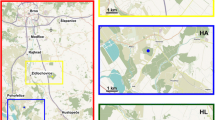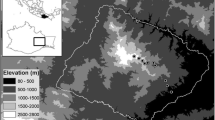Summary
Fluctuations in rainfall and size of desert rodent and plant populations for each of five consecutive years were documented on 68 sites in Mojave, Great Basin, and transition desert communities of central-southern Nevada. Post-reproduction rodent densities in the summer usually followed the seasonal patterns of winter annual success the previous spring, in turn directly related to the success of germination the preceding autumn.
In the “Dipodomys merriami environment”, at the lower elevations with relatively low rainfall and high temperatures of the Mojave Desert, D. merriami and D. deserti numbers (indicating success or failure of reproduction) closely followed the seasonal and site patterns of winter annual success. In the “Dipodomys microps environment”, at the middle and higher elevations with the relatively high rainfall and lower temperatures of the transition and Great Basin deserts, D. microps numbers followed winter annual success patterns in years of high or low rainfall in the months preceding reproduction, but there was reproduction in years of intermediate rainfall whether or not there were winter annuals in the environment. Reproductive patterns of D. merriami in the “D. microps environment” followed those of D. microps. Perognathus longimembris, the ubiquitous heteromyid of the region, also exhibited both reproductive patterns, depending on whether it was in the “D. merriami” or the “D. microps environment”. The Mojave Desert P. formosus, edaphically restricted in the region, followed the patterns of the “D. merriami environment” and its numbers were highly correlated with winter annual success.
Herbaceous perennials, capable of large germinations of plants behaving as biennials or winter annuals, are shown to have large effects on D. merriami numbers. Size of populations of Eurasian annual species of Bromus and Salsola were not correlatable with rodent reproduction patterns.
From all patterns in all environments, it is inferred that environmental conditions affecting water balance in the rodents play the key role in initiation of reproduction. Environmental moisture levels during the winter season are usually under the control of rainfall of late autumn-early winter, coincidentally the period of greatest predictability of heavy rains. The herbaceous plants, present in the winter months most years, are available sources of water (and vitamins) at the time of initiation of reproductive activity. For D. microps, identified with the mesic environments of the region, the herbaceous plants may or may not be necessary sources of water for reproduction, depending on the seasonal rainfall regime. For D. merriami, herbaceous plants appear to serve as a water reservoir required for reproduction in its usual environments. The same relationships evidently obtain for the other heteromyids, and the cricetids as a group.
Similar content being viewed by others
References
Bartholomew, G.A., Cade, T.J.: Temperature regulation, hibernation, and aestivation in the little pocket mouse, Perognathus longimembris. J. Mammal. 38 60–72 (1957)
Beatley, J.C.: Dependence of desert rodents on winter annuals and precipitation. Ecology 50, 721–724 (1969a)
Beatley, J.C.: Biomass of desert winter annual plant populations in southern Nevada. Oikos 20, 261–273 (1969b)
Beatley, J.C.: Perennation in Astragalus lentiginosus and Tridens pulchellus in relation to rainfall. Madrono 20, 326–332 (1970)
Beatley, J.C.: Russian-thistle (Salsola) species in western United States. J. Range Manage. 26, 225–226 (1973)
Beatley, J.C.: Effects of rainfall and temperature on the distribution and behavior of Larrea tridentata (Creosote-bush) in the Mojave Desert of Nevada. Ecology 55, 245–261 (1974a)
Beatley, J.C.: Phenological events and their environmental triggers, in Mojave Desert ecosystems. Ecology 55, 856–863 (1974b)
Beatley, J.C.: Environments of kangaroo rats (Dipodomys) and effects of environmental change on populations in southern Nevada. J. Mammal. 57, 67–93 (1976)
Bradley, W.G., Mauer, R.A.: Reproduction and food habits of Merriam's kangaroo rat, Dipodomys merriami. J. Mammal. 52, 497–507 (1971)
Brown, J.H., Lieberman, G.A.: Resource utilization and coexistence of seed-eating desert rodents in sand dune habitats. Ecology 54, 788–797 (1973)
Burt, W.H.: The mammals of southern Nevada. Trans. San Diego. Soc. Natur. Hist. 7 375–428 (1934)
French, N.R., Maza, B.G., Hill, H.O., Aschwanden, A.P., Kaaz, H.W.: A population study of irradiated desert rodents. Ecol. Monogr. 44, 45–72 (1974)
Hall, E.R.: Mammals of Nevada, 710 pp. Berkeley: Univ. of Calif. Press 1946
Jorgensen, C.D., Hayward, C.L.: Mammals of the Nevada Test Site. Brigham Young Univ. Sci. Bull. 6, 1–81 (1965)
Kenagy, G.J.: Saltbush leaves: Excision of hypersaline tissues by a kangaroo rat. Science 178, 1094–1096 (1972)
Kenagy, G.J.: Adaptations for leaf eating in the Great Basin kangaroo rat, Dipodomys microps. Oecologia (Berl.) 12, 383–412 (1973a)
Kenagy, G.J.: Daily and seasonal patterns of activity and energetics in a heteromyid rodent community. Ecology 54, 1201–1219 (1973b)
Mullen, R.K.: Energy metabolism and body water turnover rates of two species of free-living kangaroo rats, Dipodomys merriami and Dipodomys microps. Comp. Biochem. Physiol. 39A, 379–390 (1971)
Reichman, O.J.: Relation of desert rodent diets to available resources. J. Mammal. 56, 731–751 (1975)
Reynolds, H.G.: The ecology of the Merriam kangaroo rat (Dipodomys merriami Mearns) on the grazing lands of southern Arizona. Ecol. Monogr 28, 111–127, (1958)
Schmidt-Nielsen, K.: Desert animals, 277 pp. London: Oxford Univ. Press 1964
Soholt, L.F.: Consumption of primary production by a population, of kangaroo rats (Dipodomys merriami) in the Mojave desert. Ecol. Monogr. 43, 357–376 (1973)
Author information
Authors and Affiliations
Additional information
Studies conducted under U.S. Atomic Energy Commission Contracts AT(04-1) Gen-12 and AT(11-1) 2307, and at the Nevada Test Site as part of CETO Project 61.5.4
Rights and permissions
About this article
Cite this article
Beatley, J.C. Rainfall and fluctuating plant populations in relation to distributions and numbers of desert rodents in southern Nevada. Oecologia 24, 21–42 (1976). https://doi.org/10.1007/BF00545485
Received:
Issue Date:
DOI: https://doi.org/10.1007/BF00545485




